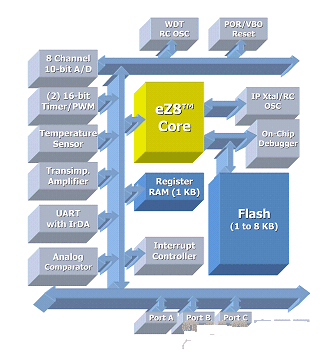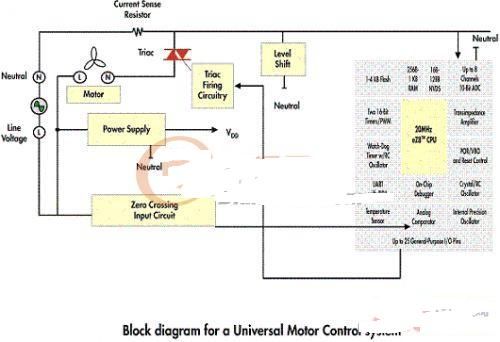Recommend a new high-efficiency, low-cost variable-speed universal motor control solution, and explain how this solution utilizes the new on-chip integrated digital module and advanced analog hardware modules to achieve speed control and downtime with minimal external components and firmware. .
This article refers to the address: http://
Cost has always been a major obstacle to the realization of intelligent motor control in various consumer appliances. Many conventional general-purpose motors used in kitchen and garage appliances, power tools, and other small appliances do not accurately control speed. The motor basically only has two states, related and open. But with digital power management systems for precise shift control, you can achieve many great advantages, including:
- lower power consumption
- higher security
- longer tool life
- easier to use
- More advanced operational controls.
- Minimize the risk of generating a surge when the appliance is turned on, causing the circuit to break
Solving cost and complexity issues
The electronics industry is so popular that the components required for systems that perform direct and accurate shift control are too expensive to be used in price-sensitive consumer appliances. This view holds that instead of developing and implementing such a control system, increasing the retail price of the final product and thus making it less attractive to people, it is better to keep the low cost of the appliance and give up the advantages of intelligent motor control. In addition, motor control applications present thorny engineering challenges due to problems such as fast overcurrent detection, fault control, system reliability, and efficiency.
Due to the need for fast and accurate loop control and the number and cost of components required to perform intelligent motor control through digital power management, these controller applications set the standard for MCUs, requiring it to deliver first-class performance and rich, comprehensive advanced features. To simplify the implementation of closed loop control design in the field of general motor control. In recent years, microcontrollers (MCUs) dedicated to motor control have been introduced, integrating 8-bit calculation engines, analog-to-digital converters (ADCs), comparators, counters, timers, and other circuits to control motor speed to meet The power requirements of the load. Due to the fast and precise closed-loop control and the number and cost of the required support components, this controller sets a new benchmark in the expectations of the MCU. The problem facing MCU manufacturers today is how to ensure that the price of the product is attractive to consumers while ensuring the integration of appropriate external components and functions.
Best method
Figure 1 shows a low-cost, high-efficiency digital power management solution for advanced motor control, especially for general motor control applications. The on-chip analog peripherals are developed by ZiLOG and integrated into one of its 8-bit MCUs.

Figure 1 ZiLOG 8-bit MCU frame diagram
In this example, the MCU's 10-bit ADC can provide up to four single-ended/differential channels and an optional 1X differential input buffer. In addition, an on-chip low-power op amp is integrated into the ADC module, enabling high-accuracy current measurements without the need for additional external components. In combination with this multi-channel ADC, the MCU's two enhanced 16-bit timer modules with pulse width modulation (PWM) and acquisition and comparison functions can operate two loads simultaneously (ie, the motor), while the direct LED drive output can be used at The LED is triggered when a preset event occurs, without the need for additional hardware. The solution also includes other features, including an analog comparator, a "fail-safe" oscillator mechanism to ensure reliability, an on-chip integrated temperature sensor, and up to 128B of non-volatile data storage space (NVDS). Figure 2 is a block diagram of a general-purpose motor using a ZiLOG MCU.

Figure 2 General Motor Control System Framework
Main functions of motor control
This special digital kilometer management solution provides the main control functions required for general purpose motors: "soft start", overcurrent fault protection and the ability to use the on-chip comparator to measure the zero crossings of the AC circuit to ensure that the MCU output signals are synchronized. Let's analyze it one by one and see how the program meets these requirements:
(1) Soft start
The "soft start" function ensures that the power is gradually and not suddenly output to the motor when the motor is turned on. Adjustable control is achieved by controlling the trigger/ignition angle of the TRIAC using the single I/O output of the MCU. This feature minimizes overshoot and uneven motion of the rotor during start-up, thereby reducing motor wear and preventing sudden changes in demand, preventing the circuit from being disconnected so that the newly opened and running appliances are turned off. .
ZiLOG's soft-start implementation uses a timer and a lookup table used when reloading the high and low bytes of the timer. Twenty evenly distributed firing angles can be achieved in one half cycle of the AC signal. In this way, the TRIAC firing angle (Figure 3) can be adjusted to adjust the power delivered to the motor. This soft-start scheme uses a 10 microsecond output pulse width to trigger the TRIAC, during which the firing angle rises from 18° to 162° (10% to 90% of a half cycle), at which point the motor transitions to normal full speed.
(2) Overcurrent fault protection
Most motor control requires overcurrent fault protection. There are many reasons for overcurrent faults, such as motor winding short circuit, motor lead short circuit, mechanical drive and connection device failure, power device damage, wiring errors, etc., which can cause electrical damage. In the event of an overcurrent fault, the motor must be stopped immediately to prevent damage, regardless of the cause. Although the protection circuit must operate quickly, it is best to turn off the PWM output cycle by cycle and resume normal operation when the fault condition cannot continue to be detected, rather than shutting down the entire system at once. If this method does not solve the problem, then shut down the system.
This motor controller solution measures the motor current with a sense resistor (Figure 2) and transmits the signal to the on-chip integrated ADC. The overcurrent threshold is configurable, and once the current reaches this threshold, the system initiates an interrupt service routine, then terminates the trigger pulse delivered to the TRIAC and eventually shuts down the system.
Posiflex All In One,All In One Pos Machine,All In One Terminal Manufacturers and Suppliers in China
DEEP DIVE
What is a POS System?
Gmaii All In One Pos Terminal lets you ring up sales and accept payments. It`s like a cash register with brains, and it can be broken down into three basic components:
Hardware
Gmaii All In One Pos Terminal has hardware that allows you to accept payments. If you`re getting a new Gmaii All In One Pos Terminal, you should make sure it accepts all forms of payment including cash, credit cards (especially chip cards), and mobile payments. If it makes sense for your business, your POS system should also print receipts, store cash in cash drawers, and scan bar codes.
a collection of pos hardware
All In One Pos Terminal
Posiflex All In One,All In One Pos Machine,All In One Terminal,All In One Pos Terminals
Shenzhen Gmaii Technology Limited , https://www.gmaiipos.com